LIGHTGRID - Lichtnetz - REDDELUZ
lightgrid, St-Germain, gridwork, 7-Ray, Violet Ray, net-of-light
Sun - Sirius - Alcyone - Galactic Centre: A model for the Sun-Sirius System
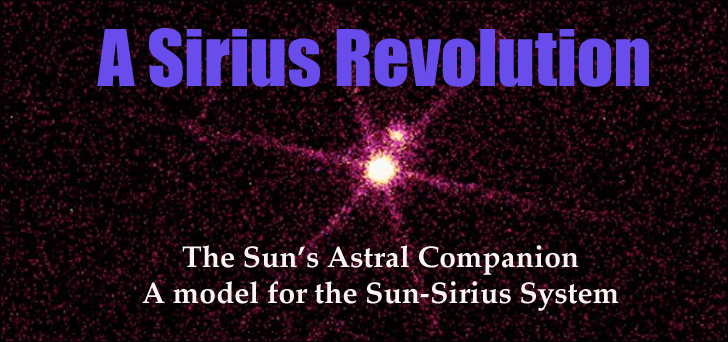 A Companion to our Sun?
In GRATITUDE to SOURCE: http://www.viewzone.com/sirius.html The vast majority of observable stars are binary or multiple star systems. In these systems, two or more stars share a common focus of revolution and are gravitationally bound to each other in defined orbits. This is such a common observation such that the gravitational interaction of multiple stars appears to be the "normal" mode of stellar system formation.
The Spire [right]. This column of star forming material is 57 trillion miles long. The close proximity of stars to each other upon formation clearly involves a high probability for gravitational binding, assuming that astral formations aren't directly driven by binary interactions (which could very well be the case). Intellectually this establishes the basis for a dual-star interaction within our Solar System. It is generally presumed that the Sun is a unique exception to this commonly observed phenomenon, however, observational evidence suggests that the Sun is moving in a defined orbit around a companion system of stars. Evidence is plentiful for the support of a model involving the interaction of multiple stars in our solar system and will be presented in this article. Also, multiple flaws abound in the centuries-old models of heliocentricism that were formed before it was understood that the solar system moves through space. Dark Star or Nemesis? Is the idea of a solar companion to our Sun unprecedented? Not at all, in fact there have been numerous scientific publications examining the evidence for a "dark star", literally speaking, to which our Sun could be gravitationally bound in a definite orbit [3]. This alternate dark star is known as Nemesis, and its proposition comes primarily from observed perturbations of orbiting objects such as the planet-sized Kuiper belt object named Sedna [4]. 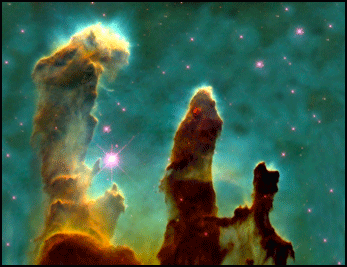 The Pllars of Creation - A Hubble Telescope image of the Eagle Nebula within the constellation Serpens. The light of super-massive stars can be seen shining forth. Walter Cruttenden of the Binary Star research institute has propounded that a solar companion need not necessarily be of the "dark star" variety. Given the paucity of empirical observations and measurements of the movement of many of the bright stars within our own local galactic sector, it is with some justification that visible stars be examined to see if any may share a common focal point with our own Solar System [5]. At the heart of the poly-solar system theory is a simplification of the mechanics of constellation precession (precession observable) with a more logical model, one that does not rely on a putative wobble of the Earth but instead explains the precession observable with the movement of the Solar System itself.
Who is our Sun's twin? Is there a candidate for binary revolution among the visible stars? Logically we could begin with the closest star to our own, which is Alpha Centauri. At a distance of 4.37 light years, it is the third brightest star and, as is common, it is itself a binary system. Another star that shows evidence of being gravitationally bound within the system and is called Alpha Proxima. Alpha Proxima is 0.2 light years from Alpha Centauri AB, about 400 times the distance of Neptune's orbit from the Sun. This shows that a dual or poly star system does not have to necessarily be in close orbital interaction. However Alpha Centauri lies at a declination of -60°, which is well out of the plane of the Solar System, and as such, has a near circumpolar motion in the sky. A more suitable candidate would be a star closer to the plane of the Solar System, or celestial equator. Sirius meets this criteria, at a declination of -17°. It is also the brightest star in the night sky, three times brighter than Alpha Centauri and twice as bright as the next brightest star Canopus. Sirius is also the 5th closest system of stars to our own [6]. More significant is the fact that The Sirius Research Group has been recording the position of Sirius for approximately 20 years now and has not recorded any measurable alteration in its location relative to the precession [7]. Imagine that you are holding hands with a friend, face to face. If you both began to spin around in a circle, your friend would appear to be stationary, while everything around them would appear to be spinning very rapidly. Your joined hands would be the focal point of the revolving motion. While the surrounding environment would not be spinning around, it would appear to be from you perspective. This illustrates how the perception of both you and your friend can be very illusionary -- you see yourselves as relatively stationary while the background whirls around you. This is very similar to our situation with respect to observations of celestial motion between the Sun and its solar companions. Our observation of this phenomenon is more complex in that we must also factor in the orbital motion of the Earth and planets around the Sun. Celestial bodies in our Solar System show harmonic resonance with the Sirius system. Pluto and Sedna are at an incline to the plane of the solar system of roughly 17°, the same as Sirius. Both have orbital periods of 250 years and 12,000 years, which are at 1:5 and 1:2 resonances with Sirius, respectively (12,000 years is roughly one half of the orbit of the Sun around Sirius, hence a 1:2 resonance). Resonance is a criterion stipulated for any system of orbiting bodies, which is why planets and moons are often times tidally locked with their parent body, and is another reason why the hypothesis of a putative wobble is very unappealing. A wobble is indicative of dynamic instability, not harmonic resonance (think of a spinning top before it falls, it begins to wobble). 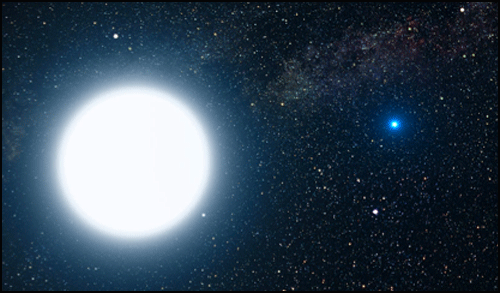 A Sirius Candidate Sirius is a binary system. Sirius A is the highly visible star, but there is a companion known as Sirius B, first described in modern times by the Dogon tribe of Mali (Africa) and subsequently verified by the observational science of astronomers. The Dogon also described a third celestial body with characteristics of a neutron star. While a neutron wouldn't be visible in the same manner as Sirius B, the combined gravitational attraction of a neutron star, a white giant star and a white dwarf would certainly provide the gravitational force needed to keep the Sun bound at a distance of 8.6 light years. In fact, the presence of a neutron star is by no means necessary for the gravitational interaction of the Sun with Sirius. 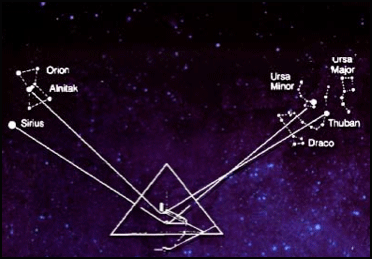 Historic and mythological descriptions of Sirius provides further insight into the nature of the relationship between the Sun and Sirius. A shaft leading from the Queens chamber of the Great Pyramid of Egypt was -- and still is -- aligned precisely with Sirius. Given the high probability that it was constructed that way, and considering that the pyramids form a star map in and of themselves, it shows how many epochs Sirius has been in a stationary position relative to the movement of the other stars. When European philosophers first hypothesized that the Earth revolves around the Sun it was a radical and revolutionary idea of that era. Nicholas Copernicus developed the model and scientific explanation by which the Earth revolved around the Sun, and proponents of the model expounded it after its posthumous publication in 1543. The process of overturning the geocentric model of the Solar System, where the stationary Earth was at the center of the Universe, was not an easy venture and came to be known as the Copernican Revolution. Like most ideas that challenge the existing paradigm, it was not well received by most philosophers of the day. This is evident in the following discourse concerning a lecture given by Giordano Bruno at Oxford University for the Polish Prince Albert Alasco in 1583, (verbatim): "When that Italian Didapper, who intituled himself Philotheus Iordanus Brunus Nolanus, magis elaborata Theologia Doctor, etc., with a name longer then his body, had in the traine of Alasco the Polish Duke, seene [sic] our University in the year 1583, his hart was on fire, to make himself by some worthy exploite, to become famous in that celebrious place. Not long after returning againe, when he had more boldly then wisely, got up into the highest place of our best and most renowned schoole, stripping up his sleeves like some juggler ... he undertook among very many other matters to set on foote the opinion of Copernicus, that the earth did goe round, and the heavens did stand still; wheras in truth it was his owne head which rather did run round, and his braines did not stand still..."[8] As can be seen by this malicious retort, the best monds of Oxford did not consider the Copernican heliocentric model in the highest regards. Eventually with the development of science and its support of empirical observations, the Heliocentric model was adopted to explain the celestial mechanics of our Solar System. Certain celestial movements could not be explained by the model however, such as the precession of the zodiacal constellations, whereby the stars associated with the constellations of the zodiac move retro-progressively across the sky over long epochs of time. In precession there is a retrograde movement, which means that the stars of the Zodiac move backwards in relation to the overall progression of the celestial sphere. So while the Sun is observed to rise in a given constellation of the zodiac at a given date, say the constellation Pisces on the Spring Equinox of March 21st, over time it is observed that Pisces rises sooner and sooner each year. Eventually, after about 2150 years, the Sun is no longer rising in Pisces on March 21st, but is rising in a different constellation altogether, like Aquarius. This is a retro-progression because it is opposite of the apparent direction of the Sun within a single year, where the Sun moves in the opposite direction of the precession through the zodiacal band of stars, so from January to February the Sun appears to travel from Aquarius into Pisces. This progression is due to the movement of the Earth around the Sun, and not the Sun around the Earth, as was purposed in the geocentric model. However the retro-progression cannot be explained by the movement of the Earth around the Sun, therefore, an additional revolving movement was introduced. Since it was known that the Earth was tilted on its axis, it was hypothesized that the Earth wobbles around this axial tilt in a precise manner every 26,000 years. This would explain the precession of the Zodiac stars, as it takes about 2150 years for each Zodiac constellation to precede and there are 12 constellations (well there use to be until the introduction of the 13th constellation Ophiuchus into the Zodiac, which is a more harmonious configuration to the natural order) that equals approximately 26,000 years. Problems with the wobble
When you take into account all the rotational motions and orbital paths of these three bodies (i.e. the Sun, Earth and Moon) it is staggering to think that a uniform force could be applied to generate a stable enough torque to maintain a 26,000 year periodicity through the precessional cycles. It should be noted that this number -- 26,000 years -- is rounded off and is not a stable time-line for the precession. The actual precession proceeds with temporal fractionalization [9], where in measurements from 1900's to 1990 it increased from 25,800 years to 25,920 years. The phenomenon of temporal fractionalization, whereby time accelerates in fractals so that more cycles are fit into shorter periods, was well known to the Mayans and is an intrinsic part of their Calendars, regarded as some of the most accurate measurements of time to this day [10]. Furthermore the interactions of the numerous other celestial bodies of the solar system were not even considered, as well as the oblate geometry of the Earth, and as such the mathematical models have been continually altered in an attempt to manufacture a proper solution. The history of the lunisolar precession model is one of problems, revisions, and the continuous addition of new inputs. Newtons' original equations did not work. d'Alembert, recognizing the earth was not a rigid body, made the first major changes, and many others since have added and changed dynamical inputs until the values have come very close to fitting the observable of approximately 50.3"p/y [50.3 arc seconds per year is a unit of astronomical measurement, it equals 30 degrees of precession about every 2000 years, 30 degrees being about equal to the diameter of the full moon]. The problem is that while current models are designed to closely approximate a fixed precession observable on a fixed date, the observed rate has been increasing at an increasing rate over the long term (100+ years), something that current models have been unable to predict. As predictability is a litmus test for the validity of a theory, the lunisolar theory is now undergoing increased scrutiny. [11] This information by itself raises serious questions about the validity of the "Wobble Hypothesis". However the major flaw of this hypothesis comes from an examination of the static position of the star Sirius in relation to precession and its historical utilization as a marker for time in the Sothic Calendar of the Egyptians.
From Africa, where the Dogons live, the star Sirius disappears below the horizon and is out of sight for a couple of months; then it appears again on the morning of July 23, when it rises about one minute before the Sun. It appears bright ruby-red, just above the horizon, almost exactly due east. Sixty seconds later the Sun emerges. So you can see Sirius for just a moment, then it's gone. This is called the helical rising of Sirius, which was a very important moment for most of the ancient world, not just for the Dogons and Egypt. The periodicity of the helical rising of Sirius was such that the Egyptians based their calendar on it [right]. Every year for millennia the appearance os Sirius coincided with the flooding of the Nile, an event that remarakbly still happens to this day. This fact alone betrays the blatant flaw in the current consensus model for the precession of the Zodiac. With the "Wobble Hypothesis", the Zodiac stars aren't actually moving; they are fixed in place. The apparent retrograde motion is only the result of the transient shift of the equinoxes. Therefore it receives it's much more common and well known description as "the Precession of the Equinoxes". In this consensus model, the equinoxes are occurring at different locations within the Earth's orbit around the Sun, and since they are occurring at different locations there is a different backdrop of stars. The equinoxes and solstices are a function of the 23.6° tilt of the Earth's axis. When the tilt is facing the Sun, the Northern hemisphere is in summer because it is receiving more sunlight and there are more daylight hours -- the days are longer and the nights are shorter. When the tilt is away from the Sun, the Northern hemisphere is in winter. This is opposite for the Southern hemisphere. The midpoints between these two extremes are the equinoxes, where the length of day and night are equal. The equinoxes retrogress because the tilt is changing its orientation to the Sun as it wobbles about. This causes the equinoxes, as well as the solstices to occur in different locations in the Earth’s orbit [right]. The problem is that if the equinoxes and solstices were occurring at different locations then Sirius could not have a precise helical rising every July 23rd from the latitude of Egypt! All of the equatorial backdrop of stars would retrogress with the wobble of the Earth, and thus Sirius would have a helical rising that regresses throughout the Year, occurring at all different seasons throughout the 26,000 year cycle (see figure 5). The only stars that would remain relatively fixed are those at the poles, although they would still have minor perturbations themselves. But his is not what is observed. As Jed Buchwald, professor of the history of science at Caltech, states: "Sirius remains about the same distance from the equinoxes -- and so from the solstices -- throughout these many centuries, despite precession" [13]. 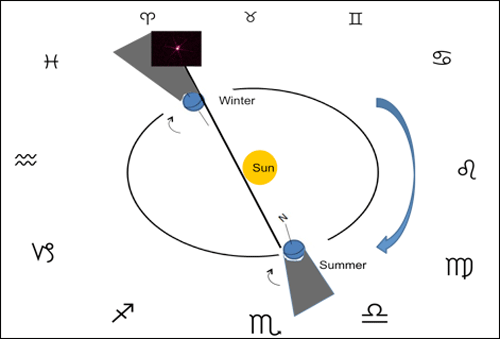 The Helical rising of Sirius in the summer, showing how the Sun and Sirius become aligned along the horizon of the Earth as it rotates into the light of the Sun. Similarly the Sun and Sirius are aligned in the winter as well, however, because Sirous is on the outside it appears directly above the Sun as it rises in the winter. This is the source of the Star of Bethlehem. It is the star Sirius. 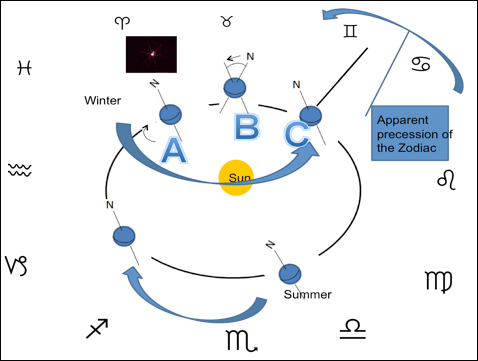 The Solstice would occur at A, but because of the retrograde wobble of the axis (b), winter now occurs at C. 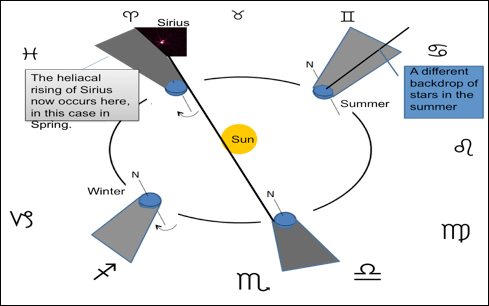 Figure 5: The wobble of the Earth's axis causes the seasons to occur at transient locations in the Earth's orbit during the cycle of the precession of the Zodiac. If the precession were due to the wobble, then Sirius would shift with the equatorial stars as well, and occur in a different season corresponding to the specific alignment. These inconsistencies are resolved in the new precessional paradigm. First off, the seasons do not regress with the precession of the Zodiac. They remain fixed in their location relative to the Sun. But not loci-static in the orbital revolution around Sirius. That is, seasons occur at different positions relative to Sirius (see figure 6). However the Sun's revolution around Sirius is so eccentric and long that perturbations in the position of Sirius are not perceived until the Sun reaches apastron. Apastron is the point in a star's orbit where it is furthest from its orbital companion, this is intrinsic to the nature of elliptical orbits. As the Sun revolves around Sirius, the zodiacal constellations shift location and appear to have a retro-progressional movement across the sky over epochs of time.  Figure 6: The Sun orbits around Sirius, and as it does so the backdrop of stars forming the Zodiac constellations change location. However the location of these seasons occur at the same position within the Earth's orbit around the Sun. As the Sun passes through the apastron points approximately every 13,000 years, Sirius would indeed appear to have a precessional migration across the sky, until eventually the heliacal rising would occur in the winter (see figure 7). And this is fine, because it does not violate any historical recordings of the behavior of Sirius. In fact, a review of the highly advanced Babylonian astronomy shows that this was actually described. 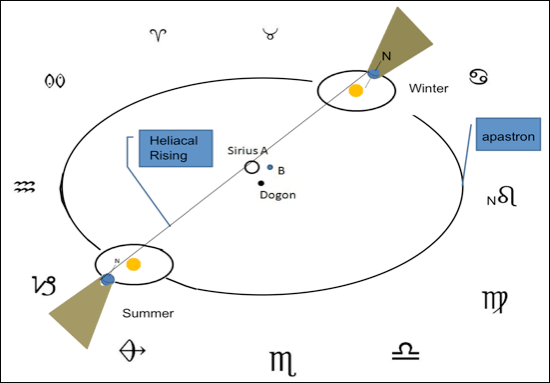 Figure 7: The term Nibiru is well known, and equally misunderstood. The Babylonians used it more as a descriptive term than a name representing a specific object. In Babylonian Astronomy it was used to describe a star -- not a planet -- as can be seen in the following examples from translations by Horowitz [14]: The Helical rising of Sirius as the Sun orbits it. Since the location of the solstices and the equinoxes are occurring at the same location within the Earth's orbit around the Sun, the helical rising is switched when the Sun reaches the opposite point in its orbit. * He [Marduk in context] set fast the position of Nibiru to fix their [the stars] bounds." What can be seen clearly here is that the term nibiru is being used to describe a star, that this star sets the course of the other stars, that is to say that it is the source of their precession, and that it is the crossing point. It is my supposition that Nibiru is referred to as a "crossing point" because when the Sun passed apastron and began its opposite revolution, Sirius would cross the sky. Not only did this crossing of Sirius mark the turning point in the Sun's orbit, but also the turning point in the Yuga cycles. The new Sun-Sirius system model satisfies the observational behavior of Sirius and the constellations of the zodiac as they regress throughout the great cycle of 26,000 years. There is no need to introduce a "wobble" in the Earth's axis, induced by the action of 9 other celestial bodies -- a theory which is just a relic from a time when the motion of the Solar System was not yet conceived. It would be sagacious not to place Sirius at the center of the Solar System, for in a fractal system there is no true center. The fractal nature of the Universe engenders its self-arrangement, or more apropos, the Universe is a holofractal graphic system [15]. Therefore there are many nested orbital interactions, going out as far as the local cluster of galaxies, which themselves have a focal point. This is nothing new. Previous civilizations understood celestial mechanics at an advanced level, and the mathematical precision of their astronomical observations is a testament to this [16]. The reason why the Egyptians and many other civilizations of that era used Sirius as their marker for the passage of time is because they picked the most stable object as their reference point. We choose the Sun as our reference point, and this is obviously highly inaccurate. Every 4 years a day has to be added to keep accurate time. But even Sirius was not accurate enough for the "Keeper's of Time", the Mayans. With their remarkably advanced astronomy they quickly detected the inaccuracies in using Sirius as a marker for the passage of time, and switched to an even more accurate cycle involving the Pleiades. There is however an even more stable reference point than the Pleiades and that is the Galactic center, which from the perspective of our galaxy is the ultimate center of rotation. And indeed the Mayan's chose the Galactic Center as a reference point to mark the passage of time, which is evident as the Mayan Long Count ends with the galactic alignment of the Solar System on December 21st 2012. Therefore, the idea that the Earth orbits the Sun, or that the Sun orbits Sirius, or that Sirius orbits Alcyone and that Alcyone orbits the Galactic Nucleus, is not revolutionary -- it's just a rediscovery of lost knowledge. Notes: [1] Sun Kwok. Delivery of Complex Organic Compounds from Planetary Nebulae to the Solar System. International Journal of Astrobiology (2009), 8: 161-167 [2] Joseph A. Nuth, Natasha M. Johnson, and Steven Manning. A self-perpetuating catalyst for the production of complex organic molecules in protostellar nebulae. Organic Matter in Space. Proceedings IAU Symposium No. 251, 2008. [3] "Astrobiology Magazine", "Cosmic Evolution" Section, "Getting WISE about Nemesis" 03/11/10, Author: Leslie Mullen, Article about Nemesis theory, also describing supporting Sedna Theory and how the WISE Sky Survey Mission may prove or disprove both theories. a. Robert Roy Britt, Nemesis: Does the Sun Have a 'Companion'?, Space.com, 3 April 2001. b. R. Foot, Z. K. Silagadze, Do mirror planets exist in our solar system? Acta Physica Polononica B32 (2001) pp. 2271–2278. c. Richard A. Muller, Measurement of the lunar impact record for the past 3.5 billion years, and implications for the Nemesis theory, Geological Society of America Special Paper 356, pp 659–665 (2002). d. Z.K. Silagadze, TeV scale gravity, mirror universe, and ... dinosaurs, Acta Physica Polonica B32 (2001) 99-128. (Provides a very entertaining and readable review of the Nemesis extinction hypothesis, including dozens of references to scientific articles on the topic.) e. Lynn Yarris. "Does a Companion Star to the Sun Cause Earth's Periodic Mass Extinctions?" Science Beat. Spring 1987 [4] SpaceDaily. Evidence Mounts For Companion Star To Our Sun. Apr 25, 2006. [5] Walter Crutenberg. Binary Research Institute. http://www.binaryresearchinstitute.org/. [6] Henry, Todd J. (2006-07-01). "The One Hundred Nearest Star Systems". RECONS. Retrieved 2006-08-04. [7] Uwe Homann. Time Equivalence of the Tropical Year and the Sidereal Year. Journal of Theoretics. [8] Frances A. Yates. Giordano Bruno, and the Hermetic Tradition. pp 208. [9] George Kavassilas. Harmonic Equation of Ascension. [10] Carl Johan Calleman. The Mayan Calendar and the Transformation of Consciousness. [11] Walter Cruttenden. Predicting Changes in Earth Orientation -Dynamic Versus Static Solar System Model. Binary Research Institute. [12] Drunvalo Melchizedek. The Ancient Secret of the Flower of Life, Volume I. [13] Jed Buchwal, Egyptian Stars under Paris Skies. http://eands.caltech.edu/articles/LXVI4/buchwald.html [14] Michael S. Heise. The Myth of a Sumerian 12Th Planet: “Nibiru†According to the Cuneiform Sources. [15] Nassim Haramein. The Resonance Project. [16]Harlestion. Mayan Treasure, Space and Time Unified at Teotihuacan, Research Summary No.5: 1971 – 2006. http://www.hharlestonjr.com/docs/Mayan-2520Treasure-2520--2520Secti.... |
Tags:
Replies to This Discussion
-
Permalink Reply by Ishema, Carol Suchecki on January 5, 2013 at 2:50am
-
Thank you Sonja for this wonderful information on Sirius!
The Tibetan master Djwhal Khul, author of the Alice Bailey books, taught in the early 20th century about the effects of the Sirian system on our world.
Here is some information I found on the Internet about Sirius:
The heart of humanity, the heart of the planet ~ the spiritual Hierarchy ~ and the heart of the sun create the channel which extends to Sirius, that great "star of initiation" within the universe. Sirius has a unique relationship with our planet Earth and through Sirius the pure energy of love flows through the solar centre and into the planetary heart.
From a compilation on - Lucis Trust website, 2005
This great Sun (Sirius) which is to our solar Logos what the Monad is to the spiritual man, has a peculiar part to play where our Earth is concerned." (Rays and Initiations 414)
Much love, Ishema
-
-
Permalink Reply by Myriel RAouine on January 5, 2013 at 9:40pm
-
Hi Ishema :-)))
I was doing some research ... Many claim our solar system revolves around Alcyone and Alcyone around Sirius and I had bought in on that - but now I see it is not so, as Sirius is nearer ... It is the Central Cun - Alcyone the Great Central Sun around which Sirius is turning - and we are all orbiting the Galactic Centre, too ... I am taking in this information FULLY now ... and see that the Mayan Calender is, in truth, a GALACTIC Calender, taking into account all these cycles, too ... they KNEW that our sun was not the only one we are continually obiting, lol!
It came to me CLEARLY when Gerhard and me were going for a night walk this full moon. We were looking up at Orion, Sirius and Aldebaran - and then from one moment to the other I KNEW the Mayan Calender was a GALACTIC Calender ... and it entered my being ...
Now, a few days later, I finally found proof about Sirius and Alcyone :-)
I'm sending you a crystalline light hug, my dearly beloved soul sister Ishema,
Sonja MYRIEL
-
-
Permalink Reply by Ishema, Carol Suchecki on January 5, 2013 at 9:53pm
-
I almost passed this information up because my understanding of astronomy is so little. I still need to read this more slowly and in depth. But I already had this information on Sirius from before when I researched it. I am so glad it is helpful to you.
I have shared this post and my comment on Sirius at another site and one person there really enjoyed it. I am looking forward to spending more time with your post and understanding more of it.
Grateful for our relationship and a big crystalline light hug for you,
Ishema
-
-
Permalink Reply by Myriel RAouine on January 5, 2013 at 10:06pm
-
How beautiful :-) I feel your light hug enteri my being :-)))
It's difficult to explain for me - I do not have the gift of clairvoyance or clairaudience or such - but sometimes I simply KNOW ... and this knowing is beyond words ... when I put it in words - the truth seems so flat ... but within me it is rich and NEW ... lol! Words cannot convey the true insight behind them ... but this article here comes CLOSE to my AHA - experience - hahahaha :-)
Seeing you in my HEART, dearest Ishema,
Sonja Myriel
-
-
Permalink Reply by Ishema, Carol Suchecki on January 7, 2013 at 7:20am
-
With a more careful read I absorbed this information:
"And indeed the Mayan's chose the Galactic Center as a reference point to mark the passage of time, which is evident as the Mayan Long Count ends with the galactic alignment of the Solar System on December 21st 2012. Therefore, the idea that the Earth orbits the Sun, or that the Sun orbits Sirius, or that Sirius orbits Alcyone and that Alcyone orbits the Galactic Nucleus, is not revolutionary -- it's just a rediscovery of lost knowledge."
So, there are four steps in the alignment to our Galactic center.
I really wanted to know where the Galactic Center is that we were just aligned with, and still are to some extent. I thought it was Sirius until I read this. Sirius is only the nearest alignment. When we talk about Source, I think this Galactic Nucleus is the place we are referring to.
Much love to you, Ishema
-
-
Permalink Reply by Myriel RAouine on February 8, 2013 at 8:08pm
-
Hi Ishema - the Galactic Nucleus is the Third Central Sun - a dark sun, the Centre of the Milky Way Galaxy :-)
Sun - Sirius - Alyone - Centre of the Galaxy = Sun - Central Sun - Great Central Sun - Third Central Sun ... And this is just a portal or opening to another Center, I suppose ... don't you think the Milky Way is also revolving around another spot? LOL!
That's the Way I come to see it now ...
Love Light Blessings,
Sonja Myriel
-
-
Permalink Reply by Myriel RAouine on February 8, 2013 at 8:10pm
-
PS.: The names I have given the Central Suns here is NOT a common one - many use different names to refer to the same sun and vice versa - It is always necessary to backcheck what is really meant ;-)
-
-
Permalink Reply by Ishema, Carol Suchecki on February 8, 2013 at 9:55pm
-
Thank you so much for your continued study of this Sonja.
When I think of, "The point of Love within the Heart of God," it is good to have some sense of where that is.
Much love, Ishema
-
-
Permalink Reply by Myriel RAouine on February 9, 2013 at 6:04pm
-
:-)
Remeber the dodecahedronal shape of the fifth heart chamber - symbolized in the PENTAGON - PENTAGRAM :-)
LOVE and LIGHT,
Sonja Myriel
-
-
Permalink Reply by Myriel RAouine on January 11, 2013 at 12:00am
-
Hi Peg :-) No, It's not that there is no wobble - but the precession of the equinox is being discussed: 
Figure 5: The wobble of the Earth's axis causes the seasons to occur at transient locations in the Earth's orbit during the cycle of the precession of the Zodiac. If the precession were due to the wobble, then Sirius would shift with the equatorial stars as well, and occur in a different season corresponding to the specific alignment.
These inconsistencies are resolved in the new precessional paradigm.
MAY I ask what you know about the tilt having to be corrected or the moon being removed? Never heard about that one!
Blessings of Love and LIGHT,
Sonja Myriel
-
-
Permalink Reply by Myriel RAouine on January 12, 2013 at 9:15pm
-
Yes, i have heard about March, too, lol :-)
What you say about the zodiac sounds interesting ... YES - I suppose you are right, because the Maya took into consideration ALL relevant cylces - and I'm sure this one did not escape their attention!
So, YES ... let's integrate ALL the lessons of the zodiac now once and for all!
I, too, received an interesting insight these days ... it has to do with the number 13 and 7 marking the peak of a wave of 13 items - like a pyramid which has 7 steps ... and us working with the 7th Ray ... I got the impression that we are entering the 7th dimension ... or somehow, that the 7th dimension is opening up to us now, too, ... and guess what the colours of the 7th dimension are? YES, right - Violet and WHITE!
It felt as if we wer "half through the zodiac" - BUT, 7 is the top of the pyramid - the highest we can get ... FROM THEN ONWARDS it's all about integrating the lessons of the peak while wandering down again ... no idea as for now how all this makes sense together, but I suppose it somehow does - in matters of BIGGER cycles, I suppose - maybe 7 times the full zodiac rounds? Lol!
Sending you a Violet and Crystalline Light Hug,
Sonja Myriel
-
Help us to anchor the energy of the New Age on Earth. Get inspired and set up a grid with the intention to help HEAL Mother Earth and all Her Beings from the wounds of the past and WEAVE a new net of living LIGHT all around the planet to help all life forms evolve into Unity Consciousness.
Ascension is not about leaving the world - it is about bringing HEAVEN down to EARTH!
We are the living BRIDGE between the worlds and dimensions, between HEAVEN AND EARTH. We are free to move in TIME and SPACE when we enter the SACRED SPACE of the Divine Chamber of the HEART where the ThreeFold Flame resides and the god given Divine Blueprint is waiting to be downloaded into our earth bodies.
The TIME to ACTIVATE our Light Body is NOW.
Love Light BLESSINGS,
Sonja Myriel RAouine
"About the Use of the Violet Flame"
I have to tell you that when you as a conscious disciple manage the Violet Flame, a parallel activity of the Violet Flame is initiated internally. This results in the vibrational awakening of your chakras. Therefore, each time when you use the gift of the Violet Flame you are asked not only to focalize your attention on what you want to transmute but also on the internal activity which takes place within yourself.
One of the consequences of the continual use of the Violet Flame is the accelerated awakening of all your chakras, you will, step by step, wake up in a different world from where you live now.
…
https://lightgrid.ning.com/group/lightgrid/forum/topics/lightgrid-tw...
Lightgrid CONNEXION Groups
This is the space for you to ORGANISE your personal connexion group, to look for likeminded people, to introduce yourSELF and say what you would like to contribute to the every expanding NET OF LIGHT around the world.
COMING TOGETHER
You have received clear guidance on a project,type of meditation, course of action to take? You are WELCOME to share here so we can start DREAMING and thus CREATING together!
Events
Blog Posts
Forgiveness Prayer & Invocation By Steven Hutchinson
Posted by Steve Hutchinson on November 23, 2025 at 4:03am 1 Comment 0 Likes
Divine Activities For Spiritual Growth By Steven Hutchinson
Posted by Steve Hutchinson on October 31, 2025 at 11:30am 0 Comments 0 Likes
Celestial Magic Invocation By Steven Hutchinson
Posted by Steve Hutchinson on September 10, 2025 at 3:26pm 0 Comments 0 Likes
Decree For Living By Steven Hutchinson
Posted by Steve Hutchinson on September 2, 2025 at 9:58am 0 Comments 0 Likes
Supreme Divine Freedom Decree By Steven Hutchinson
Posted by Steve Hutchinson on August 20, 2025 at 12:00am 0 Comments 0 Likes
Your Diamond Blue Light Decree By Steven Hutchinson
Posted by Steve Hutchinson on August 6, 2025 at 12:00pm 2 Comments 2 Likes
Videos
PHOTO Gallery
July 3rd-4th 2014 and March 20th-21st 2015:
ANCHORING the GOLDEN LIGHT FREQUENCY of CHRIST LOVE and CONSCIOUSNESS!
SUN and Central Sun Connection
Find more photos like this on LIGHTGRID - Lichtnetz - REDDELUZ
© 2025 Created by Steve Hutchinson.
Powered by
![]()
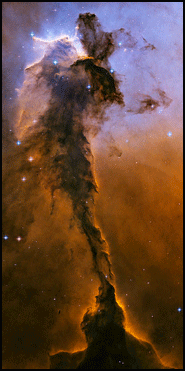 This is logical because stars are formed in nebulae that are "stellar nurseries" [right] where great conglomerates of light elements formed during the Big Bang while heavy elements were synthesized in the heart of giant, primordial stars, and were ejected upon their disruption. Special note should be made of the many complex organic compounds permeating such nebulae [1,2], because of the implications for cosmic biogenesis and panspermia -- theories which hold that life has an extrasolar origenesis.
This is logical because stars are formed in nebulae that are "stellar nurseries" [right] where great conglomerates of light elements formed during the Big Bang while heavy elements were synthesized in the heart of giant, primordial stars, and were ejected upon their disruption. Special note should be made of the many complex organic compounds permeating such nebulae [1,2], because of the implications for cosmic biogenesis and panspermia -- theories which hold that life has an extrasolar origenesis.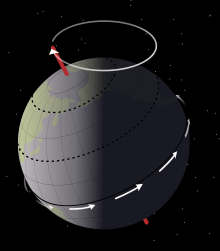
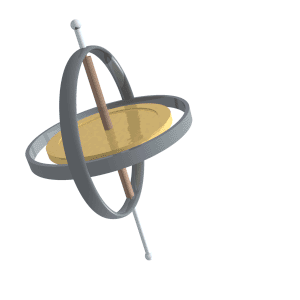
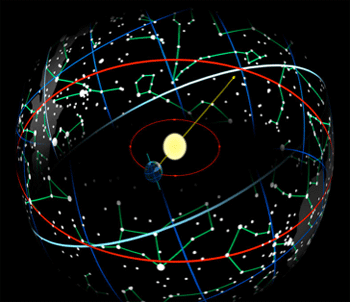 By what mechanism is a secondary retrograde rotation of the axis itself induced? The theory that was posited came to be known as Lunisolar Precession [right]. It was hypothesized that torque from the Sun and Moon supplied a force that perturbed the orientation of the axis, causing it to wobble. I call this the "Wobble Hypothesis".
By what mechanism is a secondary retrograde rotation of the axis itself induced? The theory that was posited came to be known as Lunisolar Precession [right]. It was hypothesized that torque from the Sun and Moon supplied a force that perturbed the orientation of the axis, causing it to wobble. I call this the "Wobble Hypothesis".